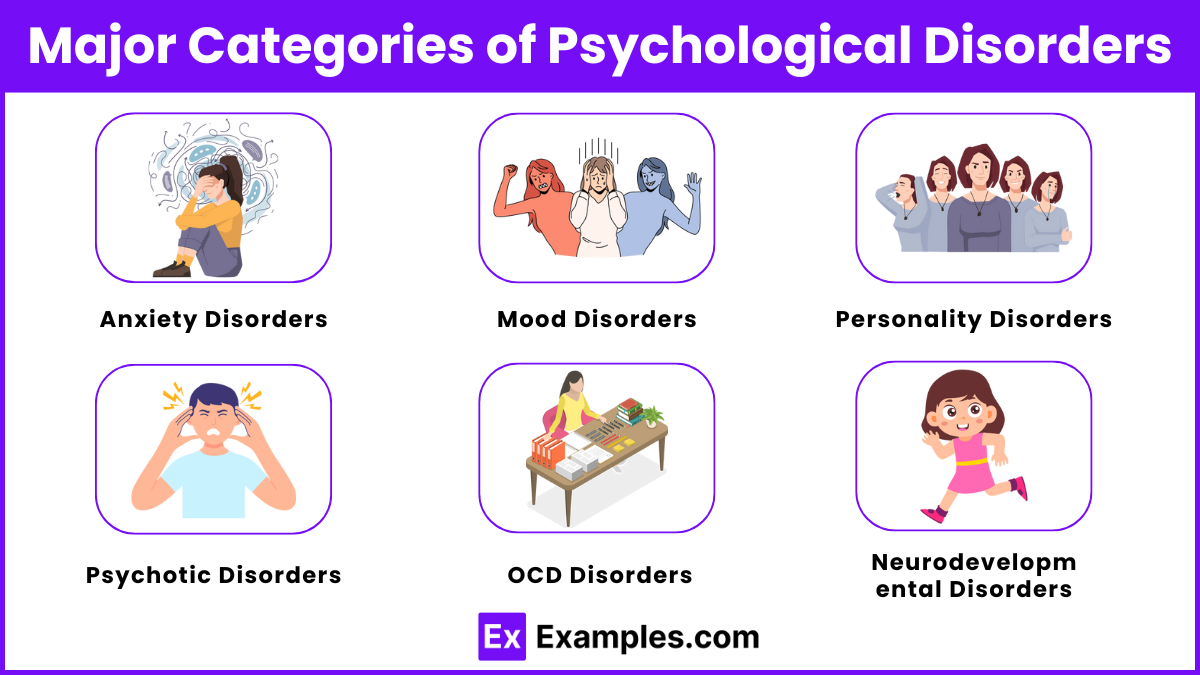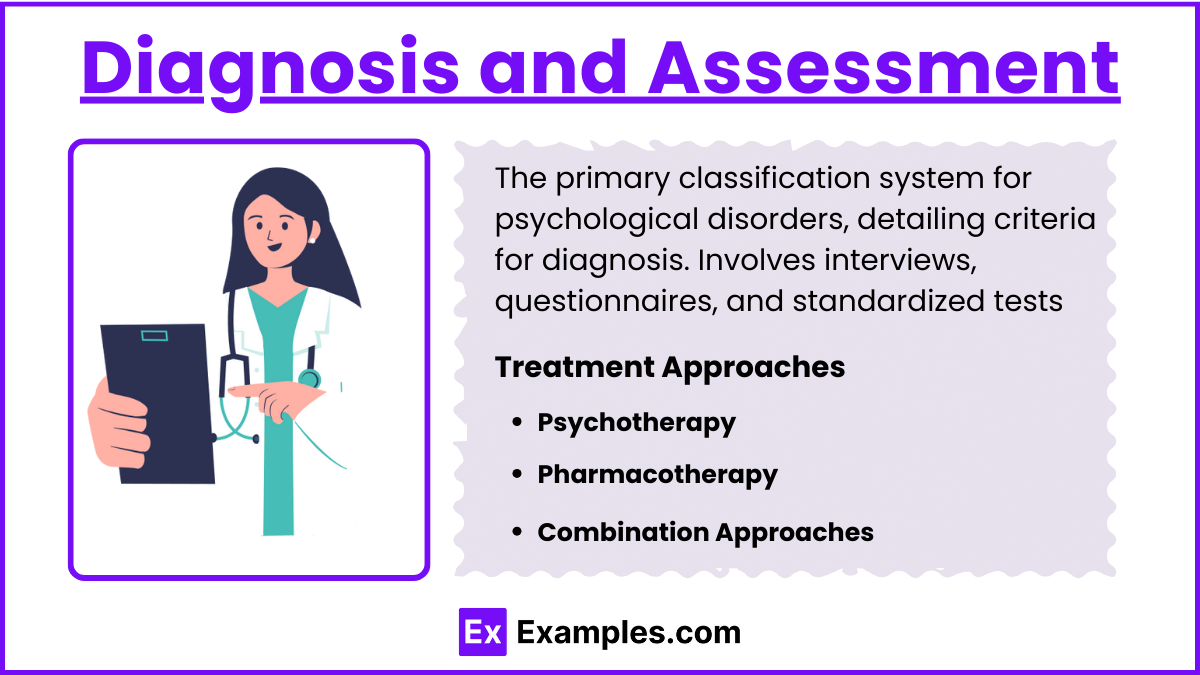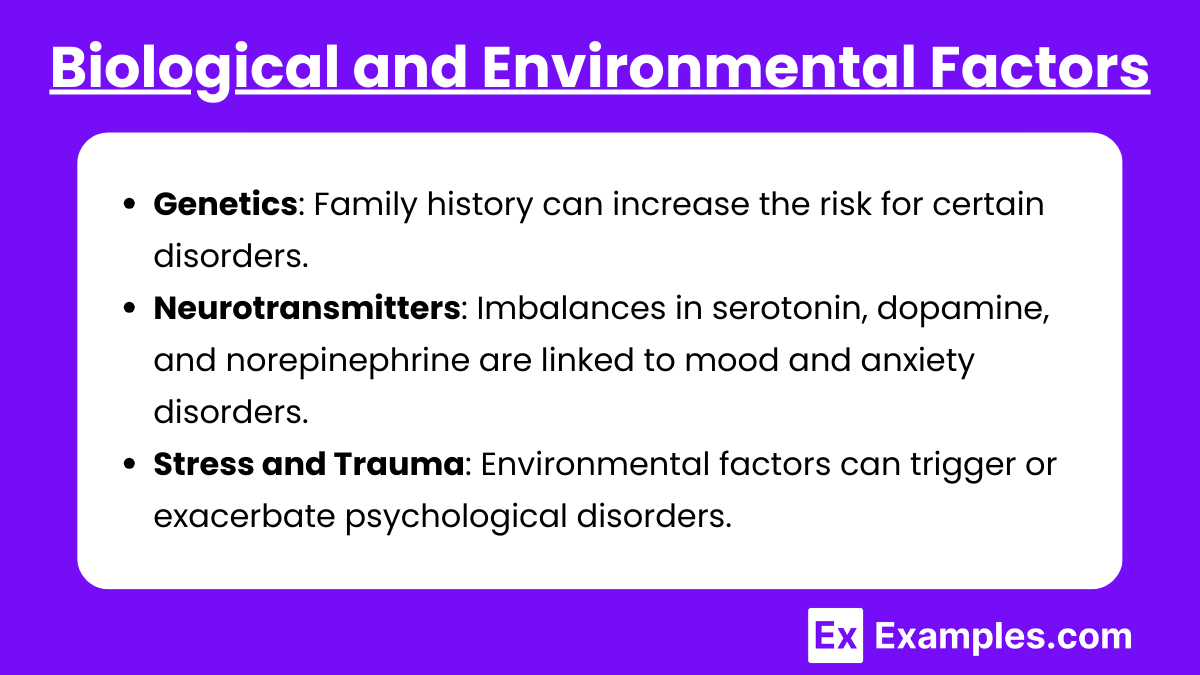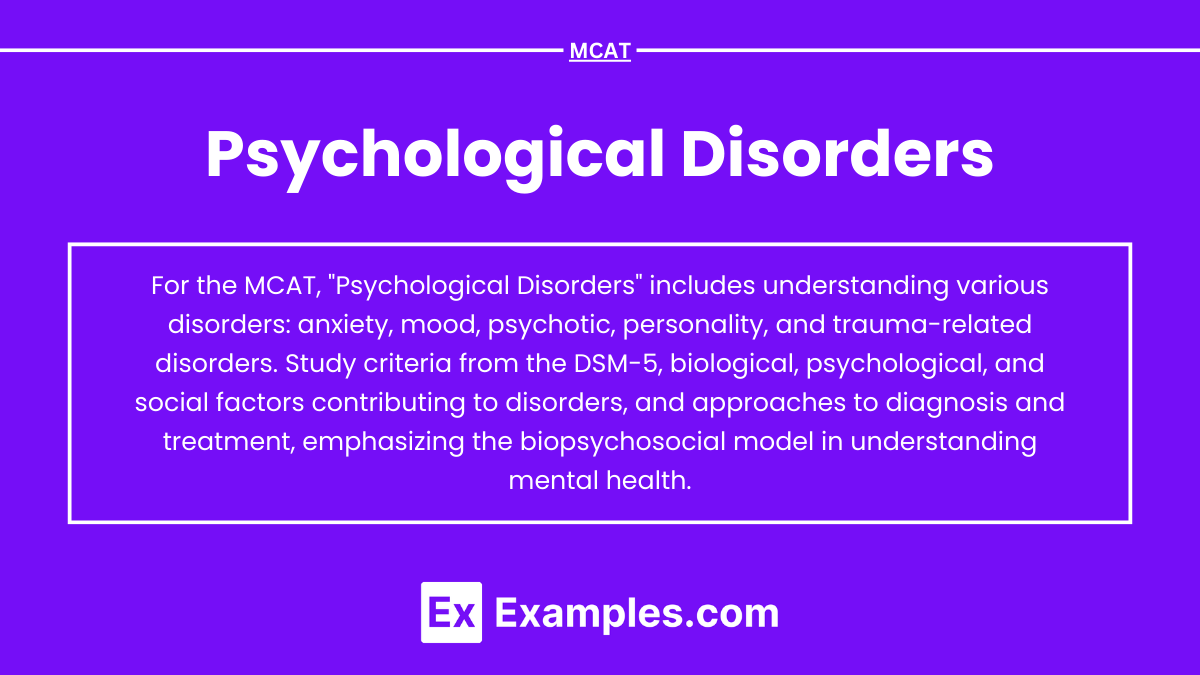Psychological disorders, also known as mental illnesses, encompass a range of conditions that affect mood, thinking, and behavior. These disorders can significantly impair an individual's ability to function in daily life, impacting relationships, work, and overall well-being. The understanding of psychological disorders integrates various disciplines, including psychology, psychiatry, and neuroscience, highlighting the complex interplay between biological, psychological, and environmental factors. Recognizing and diagnosing these disorders is essential for effective treatment and support, emphasizing the importance of mental health in overall health care.
Learning Objectives
In studying "Psychological Disorders" for the MCAT, you should learn to understand the classification and symptoms of major disorders, including anxiety, mood, personality, and psychotic disorders, as outlined in the DSM-5. Analyze the biological, psychological, and sociocultural factors influencing these disorders. Evaluate treatment methods such as psychotherapy, medication, and behavioral interventions, while understanding their mechanisms and limitations. Additionally, explore how mental health professionals diagnose disorders and assess patient functioning. Apply your knowledge to interpreting case studies and research findings in MCAT practice passages, focusing on how psychological disorders impact behavior, cognition, and emotion in both clinical and societal contexts.
Psychological disorders are patterns of behavioral or psychological symptoms that impact multiple areas of life. They cause significant distress or impairment in social, occupational, or other important areas of functioning. The American Psychiatric Association (APA) uses the Diagnostic and Statistical Manual of Mental Disorders (DSM-5) as a standardized classification for these disorders.
Major Categories of Psychological Disorders

Anxiety Disorders
Generalized Anxiety Disorder (GAD): Excessive worry about various aspects of life.
Panic Disorder: Recurrent unexpected panic attacks leading to fear of future attacks.
Specific Phobias: Intense fear of specific objects or situations.
Social Anxiety Disorder: Intense fear of social situations and being judged.
Mood Disorders
Major Depressive Disorder: Characterized by persistent feelings of sadness, hopelessness, and loss of interest.
Bipolar Disorder: Alternating episodes of depression and mania or hypomania.
Dysthymia (Persistent Depressive Disorder): Chronic, less severe depression lasting for at least two years.
Personality Disorders
Borderline Personality Disorder: Instability in relationships, self-image, and emotions, often leading to impulsive behaviors.
Antisocial Personality Disorder: Disregard for the rights of others, lack of empathy, and manipulative behavior.
Narcissistic Personality Disorder: Grandiosity, need for admiration, and lack of empathy.
Psychotic Disorders
Schizophrenia: Characterized by hallucinations, delusions, disorganized thinking, and significant functional impairment.
Schizoaffective Disorder: Features of both schizophrenia and mood disorder.
Obsessive-Compulsive and Related Disorders
Obsessive-Compulsive Disorder (OCD): Presence of obsessions (intrusive thoughts) and compulsions (repetitive behaviors).
Body Dysmorphic Disorder: Preoccupation with perceived flaws in physical appearance.
Trauma- and Stressor-Related Disorders
Post-Traumatic Stress Disorder (PTSD): Following exposure to a traumatic event, characterized by intrusive memories, avoidance, and hyperarousal.
Acute Stress Disorder: Similar to PTSD but occurs within three days to one month after the trauma.
Neurodevelopmental Disorders
Attention-Deficit/Hyperactivity Disorder (ADHD): Inattention, hyperactivity, and impulsivity affecting daily functioning.
Autism Spectrum Disorder (ASD): Developmental disorder impacting social communication and behavior.
Diagnosis and Assessment

DSM-5: The primary classification system for psychological disorders, detailing criteria for diagnosis.
Clinical Assessment: Involves interviews, questionnaires, and standardized tests to evaluate the severity and impact of symptoms.
Treatment Approaches
Psychotherapy
Cognitive Behavioral Therapy (CBT): Focuses on changing negative thought patterns and behaviors.
Dialectical Behavior Therapy (DBT): Combines cognitive-behavioral techniques with mindfulness.
Exposure Therapy: Aims to reduce anxiety responses through gradual exposure to feared stimuli.
Pharmacotherapy
Antidepressants: SSRIs and SNRIs for mood disorders.
Anxiolytics: Benzodiazepines for anxiety disorders.
Antipsychotics: For psychotic disorders like schizophrenia.
Combination Approaches
Many individuals benefit from a combination of psychotherapy and medication, tailored to their specific needs.
Biological and Environmental Factors

Genetics: Family history can increase the risk for certain disorders.
Neurotransmitters: Imbalances in serotonin, dopamine, and norepinephrine are linked to mood and anxiety disorders.
Stress and Trauma: Environmental factors can trigger or exacerbate psychological disorders.
Important Concepts to Remember
Stigma: The societal perception of mental illness can affect treatment and recovery.
Cultural Considerations: Cultural background can influence the manifestation of symptoms and the acceptance of treatment.
Comorbidity: It’s common for individuals to experience more than one psychological disorder simultaneously.
Examples
Example 1: Major Depressive Disorder (MDD)
Major depressive disorder is characterized by persistent feelings of sadness, hopelessness, and a lack of interest or pleasure in activities that were once enjoyable. Symptoms often include significant weight loss or gain, insomnia or hypersomnia, fatigue, feelings of worthlessness, and recurrent thoughts of death or suicide. This disorder can significantly impair daily functioning and may require a combination of psychotherapy, medication, or other interventions for treatment.
Example 2 : Generalized Anxiety Disorder (GAD)
Generalized anxiety disorder involves excessive, uncontrollable worry about various aspects of life, including work, health, and social interactions. Individuals with GAD often experience symptoms such as restlessness, fatigue, difficulty concentrating, irritability, muscle tension, and sleep disturbances. The anxiety can interfere with daily activities and lead to physical health problems. Treatment typically includes cognitive-behavioral therapy (CBT) and medication.
Example 3 : Bipolar Disorder
Bipolar disorder is characterized by mood swings that include emotional highs (mania or hypomania) and lows (depression). During manic episodes, individuals may feel euphoric, energetic, or unusually irritable, while depressive episodes can lead to feelings of hopelessness and lethargy. The cycling between these states can disrupt relationships and affect work performance. Treatment often involves mood stabilizers and psychotherapy.
Example 4 : Schizophrenia
Schizophrenia is a severe mental disorder that affects how a person thinks, feels, and behaves. Individuals with schizophrenia may experience hallucinations (seeing or hearing things that aren’t there), delusions (false beliefs), disorganized thinking, and significant social or occupational dysfunction. The exact cause is unknown, but a combination of genetic, brain chemistry, and environmental factors is believed to play a role. Treatment typically involves antipsychotic medications and supportive therapy.
Example 5 : Post-Traumatic Stress Disorder (PTSD)
PTSD is a mental health condition that can develop after experiencing or witnessing a traumatic event. Symptoms include intrusive memories, flashbacks, nightmares, severe anxiety, and avoidance of reminders of the trauma. Individuals may also experience changes in mood and cognition. Effective treatments include trauma-focused therapy, cognitive-behavioral therapy, and medication, aimed at reducing symptoms and improving coping mechanisms.
Practice Questions
Question 1
Which of the following best explains how psychological disorders can lead to increased healthcare costs in an economy?
A) Individuals with psychological disorders are less likely to consume healthcare services.
B) Psychological disorders decrease an individual's need for medical intervention.
C) Psychological disorders often require long-term treatment, increasing demand for healthcare services.
D) Individuals with psychological disorders typically require only short-term care, thus reducing costs.
Answer: C
Explanation: In microeconomic terms, individuals with psychological disorders often need ongoing medical attention, such as therapy, medication, or hospitalization, which increases the demand for healthcare services. This sustained demand for healthcare resources contributes to higher overall costs in the healthcare market, as providers need to allocate more resources (e.g., time, labor, facilities) to manage long-term cases. Additionally, when the demand for a service increases and the supply is limited, costs tend to rise, which can strain both individual and public healthcare budgets.
Question 2
How might the treatment of psychological disorders in a population impact labor supply in a given economy?
A) Treatment of psychological disorders increases labor supply as individuals become more productive and can work.
B) Psychological disorder treatments typically decrease labor supply by encouraging individuals to take more days off.
C) Psychological disorder treatments have no impact on labor supply in an economy.
D) Treatment of psychological disorders reduces the supply of healthcare professionals available to treat other medical conditions.
Answer: A
Explanation : From a microeconomic perspective, effective treatment of psychological disorders can increase the labor supply by improving the mental health and productivity of affected individuals. When treated, these individuals may return to the workforce or increase their work capacity, contributing positively to the economy. Improved mental health helps maintain a stable labor force and supports economic growth by reducing absenteeism and turnover. Thus, treatment not only benefits individuals but also enhances economic efficiency by increasing the available and productive labor in the market.
Question 3
What is the opportunity cost of allocating public funds toward the treatment of psychological disorders?
A) The potential economic benefits that could arise from improved mental health in the population.
B) The resources that could be spent on other public needs, such as education or infrastructure.
C) The financial savings from a decrease in psychological disorder cases.
D) The increase in government spending for unrelated healthcare expenses.
Answer: B
Explanation: In microeconomics, opportunity cost refers to the benefits that are forgone by choosing one option over another. Allocating public funds to treat psychological disorders means that these resources are not available for other potential uses, such as enhancing education, improving infrastructure, or funding other health services. This trade-off exemplifies opportunity cost, as the government must choose between competing needs. While treating psychological disorders has significant societal benefits, the opportunity cost highlights the economic balancing act required when making public spending decisions.


